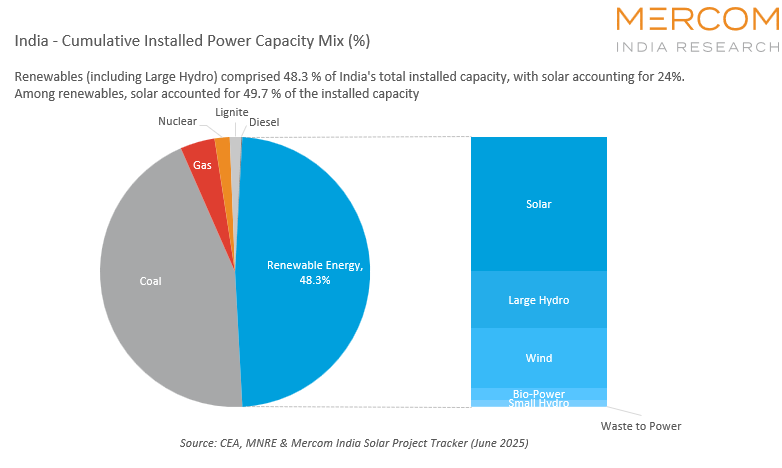Renewable Energy Capacity in India’s Power Mix Reaches 48.3% in Q2 2025
Solar accounted for 49.7 % of the total installed renewables capacity
August 8, 2025
Follow Mercom India on WhatsApp for exclusive updates on clean energy news and insights
India’s renewable energy capacity, including large hydroelectric projects, made up 48.3% of the country’s cumulative power capacity, with 234.2 GW installed at the end of the second quarter (Q2) of 2025, according to data from the Central Electricity Authority (CEA), the Ministry of New and Renewable Energy (MNRE), and Mercom’s India Solar Project Tracker.
Solar power accounted for 24% of the total installed power capacity and 49.7% of the total installed renewable capacity as of June 2025.
In the previous quarter ending March 2025, renewable energy capacity with 218.6 GW accounted for 46.1% of the power mix. Solar power accounted for 22% of the total installed capacity and 47.6% of the installed renewable energy capacity.
While renewable energy capacity in the installed power mix increased by 19% year-over-year (YoY) and 7.1% quarter-over-quarter (QoQ), the solar capacity in the installed power mix grew by 33.5% YoY and 11.8% QoQ.

India generated approximately 43 billion units (BU) of solar power in Q2 2025, marking a 19.2% YoY increase. On a QoQ basis, generation rose by 2.5%, up from 42.1 BU in the previous quarter.
Large hydropower, with a total installed capacity of 49.4 GW, accounted for nearly 10.2% of the total installed power capacity as of June 2025.
Substantial pumped storage capacity additions were made, with THDC’s Tehri PSP Unit-1 (250 MW) and Greenko’s Pinnapuram HPS Units 1–5 (5*240 MW), contributing an additional 1,200 MW of pumped hydro capacity.
Wind installations reached 51.7 GW, accounting for 10.7% of the country’s total installed power capacity, a 3.3% increase from Q1 2025.
Biomass and small hydropower contributed 2.2% and 1.1% to the total installed power capacity as of June 2025, respectively.
Energy from conventional sources
At the end of Q2 2025, the country’s installed conventional power capacity stood at 250.8 GW, accounting for 51.7% of all installations. This represents a decrease from 53.9% in the previous quarter and 43.9% in the same period last year.
Electricity generation from thermal sources is mainly fueled by coal (44.3%), gas (4.2%), nuclear (1.8%), lignite (1.4%), and diesel (0.12%). The total installed capacity of conventional power declined during the quarter. Coal-based thermal capacity decreased by 0.23%, even though two major coal projects were commissioned in Q2 2025: NTPC’s Barh I Unit-3 (660 MW) and UPRVUNL’s Obra C Unit-2 (660 MW), adding a combined 1.3 GW. However, this increase was offset by the decommissioning of around 2 GW of coal-based thermal capacity during the same period.
The quarter also witnessed the decommissioning of gas-based thermal units, leading to a 17.9% reduction in gas capacity. In contrast, nuclear power capacity increased by 7.3% compared to Q1 2025.
Despite the continued dominance of conventional power, its declining share in the total installed capacity highlights the accelerating growth of renewable energy across the country.
